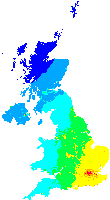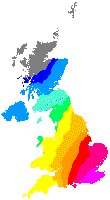
Active maps of PM10 concentrations for comparison with proposed EU Stage 1 limit values

Click on the icon to return to laqm home page

| Active maps of PM10 concentrations for comparison with proposed EU Stage 1 limit values | 
|
These maps are provided for use by local authorities who may wish to assess the likelihood of areas within their locality exceeding the EU Stage 1 Limit Values for PM10. A method for carrying out this assessment has recently been published in ‘Assistance with the review and assessment of PM10 concentrations in relation to the EU Stage 1 Limit Values’. This document was prepared by Stanger Science & Environment, in association with Air Quality Consultants and the National Environmental Technology Centre, on behalf of the Department of the Environment, Transport and the Regions (DETR), the Welsh Office and the Scottish Office. It’s aim is to provide informal assistance to those local authorities who may wish to assess the likelihood of areas within their locality exceeding the proposed EU Stage 1 Limit Values for PM10.
Two maps are provided:

| Estimated total background PM10 concentration in 2004. | 
| Estimated secondary PM10 concentration in 1996. |
| This map provides estimates of background concentrations (as µg/m3 gravimetric or equivalent) for use within the first stage of the review and assessment method. It can also be used to estimate background concentrations within the second stage if appropriate measurement data are not available. | This map provides estimates of secondary PM10 concentrations (as µg/m3 gravimetric or equivalent), for use within the second stage of the review and assessment method. | ||
Full details of the recommended review and assessment methods can be found in the reports section of this website. Copies of this document have been sent to all local authorities in England, Scotland and Wales. Further copies are available from Kay Prior at DETR, AEQ Division, Zone 4/F15, Ashdown House, 123 Victoria Street, London SW1E 6DE. 0181 890 6296.
Authorities are also reminded that DETR provides a number of telephone advice helplines which can be contacted to give specific advice on any areas of uncertainty.
![]() Click Here for helpline details
Click Here for helpline details